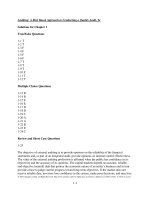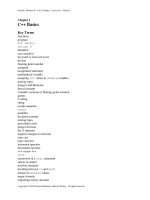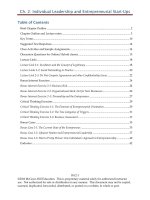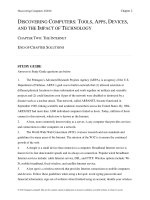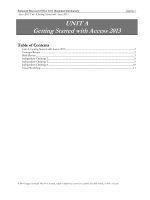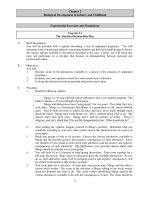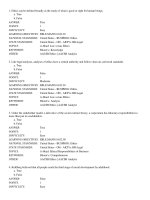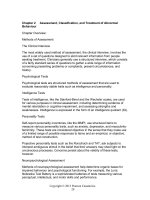Test bank and solution manual of ch02 genetic bases of child development (1)
Bạn đang xem bản rút gọn của tài liệu. Xem và tải ngay bản đầy đủ của tài liệu tại đây (676.74 KB, 20 trang )
Chapter 2
Genetic Bases of Child Development
CHAPTER OVERVIEW ............................................................................................................................................. 32
CHAPTER MODULE SUPPLEMENTS
Module 2.1: MECHANISMS OF HEREDITY ............................................................................................. 33
Learning Objectives
Key Terms
Lecture Suggestions, Classroom Activities, and Discussion Topics
Films/Videos/Internet Sources
Module 2.2: HEREDITY, ENVIRONMENT, AND DEVELOPMENT ...................................................... 36
Learning Objectives
Key Terms
Lecture Suggestions, Classroom Activities, and Discussion Topics
Films/Videos/Internet Sources
CHAPTER 2 CASE STUDY....................................................................................................................................... 38
CASE STUDY ANSWERS ......................................................................................................................................... 39
HANDOUTS ............................................................................................................................................................... 40
HANDOUT ANSWERS ............................................................................................................................................. 50
31
Copyright © 2012 by Pearson Education, Inc. All rights reserved.
CHAPTER OVERVIEW
I.
II.
Module 2.1: Mechanisms of Heredity
a. The Biology of Heredity
i. Chromosomes
1. Egg and sperm each contain 23 chromosomes
ii. In Vitro Fertilization
iii. Autosomes
iv. Sex Chromosomes
1. X and Y
v. Deoxyribonucleic Acid (DNA)
vi. Gene
1. Genotype
2. Phenotype
b. Single Gene Inheritance
i. Alleles
1. Homozygous
2. Heterozygous
ii. Dominant
iii. Recessive
iv. Incomplete Dominance
v. Sickle Cell Trait
vi. Table 2-1 Some Common Phenotypes Associated with Single Pairs of Genes
c. Cultural Influences
i. Why Do African Americans Inherit Sickle-Cell Disease?
d. Genetic Disorders
i. Inherited Disorders
1. Huntington’s Disease
2. PKU
3. Table 2-2 Common Disorders Associated with Recessive Alleles
e. Improving Children’s Lives
i. Genetic Counseling
ii. Abnormal Number of Chromosomes
1. Down Syndrome
2. Table 2-3 Common Disorders Associated with Sex Chromosomes
Module 2.2: Heredity, Environment, and Development
a. Behavioral Genetics
i. Behavioral Genetics
ii. Polygenic Inheritance
iii. Methods of Behavioral Genetics
1. Monozygotic Twins
2. Dizygotic Twins
3. Twin and adoption studies
a. Summary Table Primary Methods for Behavioral Genetics
iv. Which Psychological Characteristics are Affected by Heredity?
b. Focus on Research
i. Hereditary and Environmental Bases of Second-Language Learning
c. Paths From Genes to Behavior
i. Heredity and environment interact dynamically throughout development
1. Epigenesis
2. Heritability Coeffecient
ii. Genes can influence the kind of environment to which a child is exposed
1. Niche-Picking
iii. Environmental influences typically make children within a family different
1. Nonshared Environmental Influences
32
Copyright © 2012 by Pearson Education, Inc. All rights reserved.
CHAPTER MODULE SUPPLEMENTS
MODULE 2.1: MECHANISMS OF HEREDITY
LEARNING OBJECTIVES:
What are chromosomes and genes?
What are dominant and recessive traits? How are they inherited?
Which disorders are inherited? Which are caused by too many or too few chromosomes?
(See Handout 2-1 for a list of the learning objectives for the chapter.)
KEY TERMS:
chromosomes, p. 42
in vitro fertilization, p. 42
autosomes, p. 43
sex chromosomes, p. 43
deoxyribonucleic acid (DNA), p. 43
gene, p. 43
genotype, p. 43
phenotype, p. 43
alleles, p. 43
homozygous, p. 44
heterozygous, p. 44
dominant, p. 45
recessive, p. 45
incomplete dominance, p. 45
sickle-cell trait, p. 45
Huntington’s disease, p. 47
Down syndrome, p. 48
LECTURE SUGGESTIONS, CLASSROOM ACTIVITIES, AND DISCUSSION TOPICS:
Reproductive Technology Debate Have the class divide into two large groups. One group will debate the issue of in
vitro fertilization, and one group will debate the issue of surrogacy. Once the two large groups are decided, each
group should subdivide into two smaller groups so that both sides of the debate issue are represented (e.g., pro and
con). Give students several class periods to prepare for the debate. On debate day, the first two groups will debate
the topic of in vitro fertilization while the other two groups (in the surrogacy group) watch and evaluate. Then the
other two groups will debate the topic of surrogacy while the in vitro fertilization group watches. A format for the
debate is listed below and can be modified to fit classes of different lengths:
Debate 1: In Vitro Fertilization (30 minutes)
I. Constructive Speeches (Presentation of your side of the argument):
A. PRO side will present for 7 minutes
1. Cross-examination by the CON side for 3 minutes
B. CON side will present for 7 minutes
1. Cross-examination by the PRO side for 3 minutes
II. Rebuttal Speeches (Your response to the other side’s argument):
A. CON side will rebut for 5 minutes
B. PRO side will rebut for 5 minutes
III. Questions from Audience (5 minutes)
Debate 2: Surrogacy (30 minutes)
I. Constructive Speeches (Presentation of your side of the argument):
A. PRO side will present for 7 minutes
1. Cross-examination by the CON side for 3 minutes
B. CON side will present for 7 minutes
1. Cross-examination by the PRO side for 3 minutes
II. Rebuttal Speeches (Your response to the other side’s argument):
A. CON side will rebut for 5 minutes
B. PRO side will rebut for 5 minutes
III. Questions from Audience (5 minutes)
33
Copyright © 2012 by Pearson Education, Inc. All rights reserved.
Guest Speaker: Infertility Specialist Ask an infertility specialist to speak to your class about his/her work and the
challenging issues surrounding this new segment of the health care industry. Contact a local hospital for a referral.
What Would You Do? Handout 2-2 asks students to consider a variety of options they may face if they are
confronted with an infertility situation in their own lives. Students should complete the handout in class and discuss
the ramifications of each option in small groups.
Send in the Clones Ask your students to respond to the following two questions: Would you want to have another
“you” around? Why or why not? Their answers to the “why or why not” question should lead into a discussion of
the benefits and risks of genetic engineering in general, and cloning in particular. Several popular sources (Time and
Newsweek) have recently featured stories on cloning, which may supplement the discussion nicely. Also, inviting a
set of (preferably identical) twins to reflect on their developmental experiences will make this class session a
memorable one.
Your Genetic Profile To clarify the concepts of phenotype, genotype, and dominant and recessive alleles, ask your
students to complete Handout 2-3 either before class or as an in-class exercise. You may want to distribute Handout
2-4 to supplement the textbook coverage of the topic, but students usually do an adequate job of completing
Handout 2-3 without additional resources. While heterozygous genotypes may be difficult to determine, the point of
this exercise is to make the students maintain clear distinctions between phenotypes and genotypes, and to cause
them to reason about dominant and recessive inheritance patterns.
Genetics Worksheet For another activity to clarify the concepts of phenotype, genotype, and dominant and recessive
alleles, ask your students to complete Handout 2-5 either before class or as an in-class exercise. The point of this
exercise is to make the students maintain clear distinctions between phenotypes and genotypes, and to cause them to
reason about dominant and recessive inheritance patterns.
Your Genetic Family Tree This project is an elaboration of the “Your Genetic Profile” exercise described above.
As a homework assignment, have your students construct a family tree of genetic characteristics, including normal
characteristics and genetic disorders. With their parents’ and grandparents’ help, the students should be able to trace
their genetic ancestry back to their great-great-grandparents.
Guest Speaker: Genetic Counselor Invite a genetic counselor to speak to your class about his/her work (call a local
hospital for referrals). Have your students prepare questions in advance of the visit to make the session even more
valuable.
Dealing with Down Syndrome Depending upon availability of speakers and the interests of your class, invite to
your class an individual who is involved with caregiving for children with Down syndrome. This person may be a
parent of a child with Down syndrome, a counselor in a group home or larger facility that serves the needs of
children with developmental disorders, a preschool or elementary teacher with special education certification, etc.
Ask him/her to share some insight about these children, bringing to your class a personal (rather than simply
academic) perspective on this disorder.
Internet Annotated Bibliography Have your students use the Internet to identify 10 websites that give scholarly
information on the genetic disorders discussed in this chapter. Students should type an annotated bibliography that
includes the following:
1. The name of the website (e.g., National Down Syndrome Society).
2. A valid URL (website address, e.g., />3. A brief (one or two paragraph) review of the website. Reviews should include a brief summary of what
students can expect to find if they visit the website and a brief evaluation of the website.
As a follow-up to this activity, students can combine all of the annotated bibliographies into an Internet Resource
Directory that could be distributed in class or use it to complete the Knowing the Risks activity described next.
Knowing the Risks To provide students with a more in-depth exposure to genetic disorders, have them complete
Handout 2-6 by using the text, library resources, or the Internet (see Internet Resource list for this chapter). Students
34
Copyright © 2012 by Pearson Education, Inc. All rights reserved.
could also use their Internet Annotated Bibliography from the previous activity. This assignment works well as an
individual or small group project.
YouTube Clips for Classroom, Home, or Online Viewing
– A YouTube video about Huntington’s disease, a CBS
special (7 minutes, 55 seconds)
– a YouTube video about PKU (6 minutes, 2 seconds)
My Virtual Child My Virtual Child is an exciting new addition to the Kail text that students are sure to find both
interesting and educational. With My Virtual Child, students log on to the course website where they will be able to
create their own virtual child ( Students are then responsible for
“raising” this child from birth through age 18. Please see the Introduction to My Virtual Child listed in Chapter
1 of this manual for more details.
Part 2–Three to Nine Months: In Part 2 of My Virtual Child, students are responsible for raising their child from 3
to 9 months of age. As usual, students are asked to make a series of parenting decisions, have access to video clips
of children in this age range, and are given a set of discussion questions to reflect on either orally or in writing.
Discussion questions for this section are as follows:
1.
How does your baby’s eating, sleeping and motor development compare to the typical developmental
patterns?
2.
At 8 months of age was your child an easy, slow-to-warm-up, or difficult baby in terms of Thomas and
Chess’s classic temperamental categories? On what do you base this judgment?
3.
How is your child’s attachment to you and your partner developing? What is happening at the 3-month and
8-month periods that might affect attachment security according to Bowlby and Ainsworth, and various
research studies?
Students are able to print out these questions directly from the website in advance, and at 9 months of age, they are
given a pediatrician’s report of their child’s development and then given this set of questions again to answer (either
in written, oral, or test format, depending on the instructor’s preference). This section could be supplemented with
activities or information on object permanence (Chapter 6), Bayley Scales of Infant Intelligence (Chapter 8),
temperament (Chapter 10) and attachment (Chapter 10).
FILMS/VIDEOS/INTERNET SOURCES:
Heredity and the Environment: Blueprints for a Baby from The Developing Child series (Magna Systems, 1996, 29
minutes). Explores the various aspects of conception and the function of genes and chromosomes, and provides an
overview on inheritance and the interaction of nature and nurture. Genetic abnormalities and genetic counseling are
also covered.
Human Reproductive Biology (Films for the Humanities and Sciences, 1994, 35 minutes). This program covers the
processes leading to normal impregnation as well as various fertilization techniques (e.g., synthetic stimulation of
hormones, in vitro fertilization, micro-insemination, and test-tube embryo transfer to the womb).
Heredity and the Environment: Blueprints for a Baby from The Developing Child series (Magna Systems, 1996, 29
minutes). Explores the various aspects of conception and the function of genes and chromosomes, and provides an
overview of inheritance and the interaction of nature and nurture. Genetic abnormalities and genetic counseling are
also covered.
I am Dekel: Portrait of a Life with Down Syndrome (Films for the Humanities and Sciences, 2000, 28 minutes). A
documentary of a day in the life of Dekel Shekarzi, a 21-year-old actor, poet, dancer, and romantic. Hebrew with
English subtitles.
35
Copyright © 2012 by Pearson Education, Inc. All rights reserved.
The Lily Videos: A Longitudinal View of Life with Down Syndrome (Davidson Films – see details below). Elizabeth
Grace captures the essence of her daughter, Lily, as a schoolgirl, a young woman, and an adult with Down
syndrome. An engaging and inspiring video series.
Lily: A Story About a Girl Like Me (1978, 14 minutes). Lily at age 10 (3 rd grade).
Lily: A Sequel (1988, 15 minutes). Lily, at age 20, graduates from high school, works at a
restaurant, and resides in a group home.
Lily at Thirty (1997, 14 minutes). Lily lives in an apartment in an independent living program and
is working in a supermarket. She shares her views on life with her disability.
Duo: The True Story of a Gifted Child with Down Syndrome (1996, produced by Alexandre Ginnz and Sergio
Sanchez).
Sean’s Story—A Lesson in Life – segment from Lifespan Human Development, Series III (ABC News/Prentice Hall
Video Library, 1996, 16.5 minutes). Video segment details the first months of public school for an 8-year-old child
with Down syndrome. Issues of mainstreaming and developmental expectations are portrayed.
Special Needs Students in Regular Classrooms? Sean’s Story (Films for the Humanities and Sciences, 1994,
45 minutes). This video tells the story of Sean, an 8-year-old with Down syndrome, whose parents fought to have
him in regular classrooms. Comparisons are made to Sean’s friend, Bobby, who also has Down syndrome but is
enrolled in a special education school.
Children of Men (Universal Pictures, 2006, 109 minutes) and The Handmaid’s Tale (Bioskop Films, 1990, 108
minutes) – both films deal with a fictionalized future Earth in a time when nationwide infertility problems raise all
sorts of ethical issues that students might want to consider.
– website of the National Down Syndrome Society
– Human Genome Project information, gene
mapping, and links to the Genetic World (social issues, basic genetic information, resources, etc.)
– Home page for the National March of Dimes organization. This site contains
information and links that pertain to genetic and chromosomal disorders.
- a website about sickle-cell anemia
Websites about Huntington’s Disease
/> />
- a website about PKU
MODULE 2.2: HEREDITY, ENVIRONMENT, AND DEVELOPMENT
LEARNING OBJECTIVES:
What methods do scientists use to study the impact of heredity and environment on children’s development?
How do heredity and environment work together to influence child development?
KEY TERMS:
behavioral genetics, p. 50
polygenic inheritance, p. 51
monozygotic twins, p. 52
dizygotic twins, p. 52
epigenesis, p. 58
heritability coefficient, p. 58
niche-picking, p. 59
nonshared environmental influences, p. 60
36
Copyright © 2012 by Pearson Education, Inc. All rights reserved.
LECTURE SUGGESTIONS, CLASSROOM ACTIVITIES, AND DISCUSSION TOPICS:
Nature/Nurture Interactions Sandra Scarr’s theory of genotype-environment interaction warrants a demonstration
due to its complexity. In her chapter in a book entitled The Emergence of Personality (1987), Scarr provides several
examples of how genetics and environment interact in shaping one’s personality. Handout 2-7 presents several
examples that Scarr used to illustrate the three types of genotype-environment interactions. Have your students
indicate which type of interaction each example depicts.
Great Expectations Have students watch the video Great Expectations (see reference below in the Films/Videos
section). Students can write a summary/review of the video, or you can use the following questions to help guide
and evaluate students’ viewing of the film:
According to the video, does divorce affect boys and girls differently? Give evidence to support your
answer.
Discuss what you believe Urie Bronfenbrenner meant when he described the nature versus nurture
controversy as “out-of-date.”
According to the video, how is development affected by both our own childhood and the experiences of
our parents?
Discuss Jerome Kagan’s idea that some aspects of growth are universal.
Discuss Jerome Kagan’s beliefs about how differences in people emerge.
YouTube Clips for Classroom, Home, or Online Viewing
- A YouTube video about identical twins
separated at birth (8 minutes, 51 seconds)
– A YouTube video about nature vs nurture (1
minute, 5 seconds)
FILMS/VIDEOS/INTERNET SOURCES:
Great Expectations (Ambrose Video Publishing, 1991, 60 minutes). From the series Childhood, this video provides
a look at the importance of both “nature” and “nurture,” and how different societies approach birth.
Biological Growth: Nature’s Child (Insight Media, 1991, 60 minutes). Explores the nature-nurture controversy.
Examines the influences of genetics on behavior, concentrating on hereditary contributions to intelligence,
temperament, personality, sex differences, and mental illness.
Like Two Peas in a Pod (Filmmakers Library, 1991, 55 minutes). Reviews the psychology of twins by following
three sets of twins as they develop.
The Ecology of Development (Insight Media, 1992, 30 minutes). This video reviews how environmental and genetic
factors influence the development of children from 12 families in 5 countries.
The Human Animal: Nature and Nurture (Films for the Humanities and Sciences, 1991, 52 minutes). Produced by
Phil Donahue, this video includes classic footage from Harlow’s lab and the Minnesota twin study as well as
interviews with prominent psychologists covering the nature/nurture debate.
– Article from the Gale Encyclopedia of
Psychology on the heredity-environment connection
37
Copyright © 2012 by Pearson Education, Inc. All rights reserved.
CHAPTER 2 CASE STUDY
Genetic Bases of Child Development
Barbara and Brenda are adolescent twins. They both have brown hair, hazel eyes, wavy hair, freckles, thin
lips, and, at the moment, they have cases of poison ivy. As a child, Brenda enjoyed playing and actively exploring
her environment; Barbara was quieter and enjoyed being held by her mother, who was a bright and shy woman.
Since Brenda was the “explorer,” her extroverted, athletic father (unintentionally) played with her more than he
played with Barbara. Barbara participated in more solitary play activities or worked on crafts with her mother. In
their teenage years, Brenda was described by her peers as “outgoing, animated, spontaneous, talkative, friendly, and
popular.” Barbara was described by her peers as “quiet, shy, intelligent, and nice.”
1. Many characteristics of Barbara and Brenda are listed in the case above. Do these features represent their
phenotypes or genotypes?
2. Which of Barbara and Brenda’s characteristics are the results of homozygous genotypes and which are likely
the results of heterozygous genotypes?
3. Which characteristics in the above descriptions of Barbara and Brenda are likely the results of single gene
inheritance? Polygenic inheritance?
4. What types of careers are Barbara and Brenda likely to pursue? Career selection is an example of what type of
gene-environment relation?
38
Copyright © 2012 by Pearson Education, Inc. All rights reserved.
CASE STUDY ANSWERS
Genetic Bases of Child Development
1.
Phenotypes
2.
Homozygous versus heterozygous genotype:
Homozygous Genotype
Brown hair
Thin lips
Susceptibility to poison ivy
3.
Single versus polygenic inheritance:
Single Gene Inheritance
Hair color
Eye color
High cheek bones
Narrow noses
4.
Heterozygous Genotype
Hazel eyes
Wavy hair
Freckles
Polygenic Inheritance
Childhood activity levels
Teenage personality characteristics
Teenage intelligence
Barbara is likely to pursue a career that does not involve extensive interaction with others (e.g., writing,
computer programming). Brenda’s outgoing personality will likely guide her toward a career in sales,
marketing, politics, law, etc. These are both examples of niche picking.
39
Copyright © 2012 by Pearson Education, Inc. All rights reserved.
HANDOUT 2-1
Discussion Questions for Chapter 2
1. What are chromosomes and genes?
2. What are dominant and recessive traits?
3. How are they inherited?
4. Which disorders are inherited?
5. Which are caused by too many or too few chromosomes?
6. What methods do scientists use to study the impact of heredity and environment on children’s development?
7. How do heredity and environment work together to influence child development?
40
Copyright © 2012 by Pearson Education, Inc. All rights reserved.
HANDOUT 2-2
What Would You Do?
Directions: Imagine that you have been married for 15 years and are 38 years old. You and your spouse have not
yet been able to conceive a child, even though you have been trying concertedly for the past eight years. Rank the
following options from most to least preferred (1 = most, 8 = least), and provide some reasons (pros and cons) for
your ranking.
______ a. Hire a surrogate mother (if the wife is infertile).
Pros/Cons:
______ b. Contact a sperm bank (if the husband is infertile).
Pros/Cons:
______ c. Pay a lawyer a minimum of $10,000 to try to “buy” a baby for you.
Pros/Cons:
______ d. Become clients at a fertility clinic even though each attempt at pregnancy will cost $10,000 and the
chance of conceiving is very small.
Pros/Cons:
______ e. Apply to adopt a baby through legal channels although it will take at least five years if you ever get
a baby.
Pros/Cons:
______ f. Adopt a “hard-to-adopt” child (i.e., an older child, one with serious handicaps, etc.).
Pros/Cons:
______ g. Adopt a baby from another country at the cost of $15,000–$40,000 even though it will take 2-3 years
and may not be successful.
Pros/Cons:
______ h. Redirect your energies into your career, hobbies, socializing, civic activities, etc.
Pros/Cons:
Source: DeWolff, D. K. & Kail, R. V. (1993). Instructor’s Resource and Testing Manual to Accompany
Developmental Psychology (5th ed.). Englewood Cliffs, NJ: Prentice Hall.
41
Copyright © 2012 by Pearson Education, Inc. All rights reserved.
HANDOUT 2-3
Your Genetic Profile
Directions: Complete the following table by listing the characteristics of your parents and yourself.
Characteristic
Mother’s Trait
(her phenotype)
Father’s Trait
(his phenotype)
Your Trait
(your phenotype)
Eye color
Hair color
Height
(tall, average,
short)
Body weight
(overweight,
average,
underweight)
Blood type
Personality
(shy or
outgoing;
passive or
aggressive, etc.)
*Homozygous, heterozygous, or incomplete dominance
42
Copyright © 2012 by Pearson Education, Inc. All rights reserved.
Your Genotype *
HANDOUT 2-4
Dominant and Recessive Characteristics
Characteristics in the left-hand column dominate over those characteristics listed in the right-hand column.
Dominant Traits
Recessive Traits
eye color
brown
gray, green, hazel, blue
vision
farsightedness
normal vision
normal vision
normal vision
normal vision
nearsightedness
night blindness
color blindness*
hair
dark hair
non-red hair
curly hair
full head of hair
widow’s peak
blonde, light, red hair
red hair
straight hair
baldness*
normal hairline
facial features
dimples
unattached earlobes
freckles
broad lips
no dimples
attached earlobes
no freckles
thin lips
appendages
extra digits
fused digits
short digits
fingers lack one joint
limb dwarfing
clubbed thumb
double-jointedness
normal number of digits
normal digits
normal digits
normal joints
normal proportion
normal thumb
normal joints
other characteristics
immunity to poison ivy
normal skin pigmentation
normal blood clotting
normal hearing
no PKU (normal)
Type A blood
Type B blood
Rh-positive blood
susceptibility to poison ivy
albinism
hemophilia *
congenital deafness
phenylketonuria (PKU)
Type O blood
Type O blood
Rh-negative blood
* sex-linked characteristic
Source: Horton, S. & Preisser, G. (1997). Instructor’s Resource Manual to Accompany Development Across
the Lifespan. Upper Saddle River, NJ: Prentice Hall.
43
Copyright © 2012 by Pearson Education, Inc. All rights reserved.
HANDOUT 2-5
Genetics Worksheet
Dominant-Recessive Genetic Relationships (Homozygous-Homozygous):
B = Dark Hair (Dominant)
b = Blonde Hair (Recessive)
Dark-Haired Father (Homozygous)
Blonde Mother (Homozygous)
Genotype: BB
Phenotype: Dark Hair
Genotype: bb
Phenotype: Blonde Hair
Genotype: _____ Genotype: _____ Genotype: _____ Genotype: _____
Phenotype: _____
Phenotype: _____
Phenotype: _____
Phenotype: _____
Dominant-Recessive Genetic Relationships (Heterozygous-Homozygous):
Dark-Haired Father (Heterozygous)
Blonde Mother (Homozygous)
Genotype: Bb
Phenotype: Dark Hair
Genotype: bb
Phenotype: Blonde Hair
Genotype: _____ Genotype: _____ Genotype: _____ Genotype: _____
Phenotype: _____
Phenotype: _____
Phenotype: _____
44
Copyright © 2012 by Pearson Education, Inc. All rights reserved.
Phenotype: _____
Dominant-Recessive Genetic Relationships (Homozygous-Heterozygous):
B = Dark Hair (Dominant)
b = Blonde Hair (Recessive)
Dark-Haired Father (Homozygous)
Dark-Haired Mother (Heterozygous)
Genotype: BB
Phenotype: Dark Hair
Genotype: Bb
Phenotype: Dark Hair
Genotype: _____ Genotype: _____ Genotype: _____ Genotype: _____
Phenotype: _____
Phenotype: _____
Phenotype: _____
Phenotype: _____
Dominant-Recessive Genetic Relationships (Heterozygous-Heterozygous):
Dark-Haired Father (Heterozygous)
Dark-Haired Mother (Heterozygous)
Genotype: Bb
Phenotype: Dark Hair
Genotype: Bb
Phenotype: Dark Hair
Genotype: _____ Genotype: _____ Genotype: _____ Genotype: _____
Phenotype: _____
Phenotype: _____
Phenotype: _____
45
Copyright © 2012 by Pearson Education, Inc. All rights reserved.
Phenotype: _____
Dominant-Recessive Genetic Relationships (Codominance):
A = Type A Blood (Dominant)
B = Type B Blood (Dominant)
o = Type O Blood (Recessive)
Father (Type A –Homozygous)
Mother (Type B–Homozygous)
Genotype: AA
Phenotype: Type A Blood
Genotype: BB
Phenotype: Type B Blood
Genotype: _____ Genotype: _____ Genotype: _____ Genotype: _____
Phenotype: _____
Phenotype: _____
Phenotype: _____
Phenotype: _____
Father (Type A –Heterozygous)
Mother (Type B–Heterozygous)
Genotype: Ao
Phenotype: Type A Blood
Genotype: Bo
Phenotype: Type B Blood
Genotype: _____ Genotype: _____ Genotype: _____ Genotype: _____
Phenotype: _____
Phenotype: _____
Phenotype: _____
46
Copyright © 2012 by Pearson Education, Inc. All rights reserved.
Phenotype: _____
Dominant-Recessive Genetic Relationships (X-Linked or Sex-Linked)
X = Normal Female Sex Chromosome (Dominant)
Y = Normal Male Sex Chromosome
Xh = Female Sex Chromosome (Hemophilia Trait – Recessive)
Unaffected Father
Carrier Mother
Genotype: XY
Phenotype: Unaffected Male
Genotype: XXh
Phenotype: Carrier Female
Boy 1
Boy 2
Girl 1
Girl 2
Genotype: _____ Genotype: _____ Genotype: _____ Genotype: ______
Phenotype: _____
Phenotype: _____
Phenotype: _____
Phenotype: ______
Hemophiliac Father
Carrier Mother
Genotype: XhY
Phenotype: Hemophiliac Male
Genotype: XXh
Phenotype: Carrier Female
Boy 1
Boy 2
Girl 1
Genotype: _____ Genotype: _____ Genotype: _____ Genotype: ______
Phenotype: _____
Phenotype: _____
Phenotype: _____
47
Copyright © 2012 by Pearson Education, Inc. All rights reserved.
Girl 2
Phenotype: ______
HANDOUT 2-6
Knowing the Risks
Directions: Knowledge of genetic disorders may be your best protection against them. Use the textbook, library
resources, or the Internet to locate information on the characteristics, risk factors, and available treatments (if any)
for the genetic disorders listed below.
Genetic Disorder
Characteristics of the
Disorder
Risk Factors
PKU
(phenylketonuria)
Down syndrome
Sickle-cell disease
Huntington’s disease
48
Copyright © 2012 by Pearson Education, Inc. All rights reserved.
Treatment (if any)
HANDOUT 2-7
Nature/Nurture Interactions
Sandra Scarr (1987) illustrated several ways in which one’s environment and one’s genetics interact to shape one’s
personality. For each of the numbered examples below, label the type of nature/nurture interaction by using one of
the following types of interactions:
A. passive gene-environment relation
B. evocative gene-environment relation
C. active gene-environment relation (niche picking)
______
1.
Smiling, active babies receive more social stimulation than fussy, difficult infants.
______
2.
Parents who are sociable will expose their children to more social situations than parents who are
socially inept and isolated.
______
3.
Cooperative, attentive preschoolers receive more pleasant and instructional interactions from the
adults around them than uncooperative, distractible children.
______
4.
Children who are quick, strong, and agile will likely become involved in athletic activities.
______
5.
Preschoolers with long attention spans and good spatial skills often seek games and puzzles to play.
______
6.
Parents who are assertive, faced with a child who is passive, may exert more pressure and do more
assertiveness training than they would with a more assertive offspring.
Source: Scarr, S. (1987). “Personality and experience: Individual encounters with the world.” In J. Aronoff,
A. I. Rabin, & R. A. Zucker (Eds.), The Emergence of Personality (pp. 67-68). New York: Springer.
49
Copyright © 2012 by Pearson Education, Inc. All rights reserved.
HANDOUT ANSWERS
HANDOUT 2-5: Genetics Worksheet
Dominant-Recessive Genetic Relationships—Homozygous-Homozygous
Genotypes: Bb, Bb, Bb, Bb
Phenotypes: Dark hair, Dark hair, Dark hair, Dark hair
Dominant-Recessive Genetic Relationships—Heterozygous-Homozygous
Genotypes: Bb, Bb, bb, bb
Phenotypes: Dark hair, Dark hair, Blonde hair, Blonde hair
Dominant-Recessive Genetic Relationships—Homozygous-Heterozygous
Genotypes: BB, Bb, BB, Bb
Phenotypes: Dark hair, Dark hair, Dark hair, Dark hair
Dominant-Recessive Genetic Relationships—Heterozygous-Heterozygous
Genotypes: BB, Bb, Bb, bb
Phenotypes: Dark hair, Dark hair, Dark hair, Blonde hair
Dominant-Recessive Genetic Relationships—Codominance- A-Homozygous-B-Homozygous
Genotypes: AB, AB, AB, AB
Phenotypes: AB blood type, AB blood type, AB blood type, AB blood type
Dominant-Recessive Genetic Relationships—Codominance- A-Heterozygous-B-Heterozygous
Genotypes: AB, Ao, Bo, oo
Phenotypes: AB blood type, A blood type, B blood type, O blood type
Dominant-Recessive Genetic Relationships—Sex-Linked—Unaffected Male-Carrier Mother
Genotypes: XY, XhY, XX, XXh
Phenotypes: Normal male, Hemophiliac male, Normal female, Carrier female
Dominant-Recessive Genetic Relationships—Sex-Linked—Hemophiliac Male-Carrier Mother
Genotypes: XY, XhY, XXh, XhXh
Phenotypes: Normal male, Hemophiliac male, Carrier female, Hemophiliac female
HANDOUT 2-7: Nature/Nurture Interactions
Answer options:
A. passive gene-environment relation
B. evocative gene-environment relation
C. active gene-environment relation
Answer key:
1.
2.
3.
4.
5.
6.
B
A
B
C
C
A
50
Copyright © 2012 by Pearson Education, Inc. All rights reserved.
